
|
|
|
|
 |
|
Home Site Search Contact Us Subscribe
|
|
|
|
INSIGHT: A Story of a Place: Transforming America's Cities
Placemaking is the art of architecture connecting spaces to communities. by Alexander Wu, KMD (Kaplan McLaughlin Diaz) August 25, 2003 We have encountered unprecedented changes in the past few decades. From the cultural diversity of an ever-growing and nomadic population, and inventions in technology that have transformed our lifestyles, to genomic innovations that are helping us to live longer and healthier lives. The results can be chaotic, which is not necessarily a bad thing if it can influence a progressive movement towards the support of a global economy as well as move us closer to erasing the lines of discrimination to gender, religion, culture, ethnicity, and the handicapped. As technology and other innovations allow us to communicate instantaneously in a “whenever-from-anywhere” society, perhaps there is more of a need for reinvention in the workplace and in our cities to further promote interaction. Placemaking is not a matter of happenstance. Effective placemaking requires several important details to be considered before a project’s inception: developing a context that responds to the scale of the surrounding environment, consideration of the emotional impact it will have on its users, and an understanding and love of the history of the built world. To be successful, a project needs to cast its own spell on its users and community by creating a variety of experiences. Placemaking realizes in the buildings and, equally important, in the spaces defined by the buildings, a shared sense of community and a connection with the language and culture of a city. A City Centerpiece The Oakland [California] Federal Building is an example of placemaking at work, and is a key element in the revitalization of Oakland’s downtown. The architecture symbolizes the broad strokes of a city’s rebirth, and the design has become the figurative gateway and centerpiece to a new city skyline. The 1.05 million-square-foot complex occupies two square blocks and is designed to accommodate more than 4,000 employees. A five-story building cluster that surrounds the two 18-story towers includes a childcare center, retail, courthouses, a conference center, and a cafeteria on the ground floor. Quintessentially, the Federal Building has successfully recognized and addressed the need for creating a “sense of place.” The sunny plaza, formal garden, and glowing central rotunda stand as something less lofty, possibly more intimate and more important to the community. It has become a public place for Oaklanders to enjoy, gather, and share ideas. The piazza and garden create an inviting and warm landscape retreat and place to meet – the pedestrian-friendly paths encourage gathering. The rotunda that separates the main plaza area from the formal garden seduces visitors and passersby to look through to the garden area by creating a variety of visual experiences. The two towers connected by the rotunda symbolize hope and civic pride for the community. The buildings’ octagonal form was created to resolve certain contextual disparities of the street grid and surrounding neighborhood. Similarly, the stone palette of beige and white was chosen to pick up the golden hues of the historic Oakland Tribune Tower and the creamy whiteness of the City Hall. Today, looking from San Francisco and the Oakland Bay Bridge, there is a much different view of Oakland than in past decades. The revitalization effort has been a catalyst for many new high-rise buildings and a new skyline in Oakland. What was once a bleak downtown area has been transformed into a unified Federal District that is an integral part of the downtown community. More than the skyline and neighborhood has been transformed. The civic destination has attracted developers such as the Shorenstein Company as well as Fortune 500 companies as its neighbors. The Federal Building now stands as a symbol of Oakland’s revitalization, and it is regularly featured in the city’s publications (including the cover of the Pacific Bell Yellow Pages), and news media routinely use the building for backgrounds representing Oakland. It has also helped create a strong base for jobs and wage growth and reflects a dynamic economy, a shift that resulted in the city ranking eighth in a recent Forbes survey of Best Places for Business and Careers. Cornerstones for Revitalizing Neighborhoods KMD has brought the same spirit of reinvention and placemaking to other projects such as Two Rodeo Drive in Beverly Hills and One Colorado located in Old Pasadena, California. Both projects are cornerstones in the revitalization efforts of the two cities that serve millions of visitors every year. Moving beyond a conventional covered mall, One Colorado is a retail and entertainment environment that has drawn a new mix of people to a previously blighted neighborhood by creating an exciting destination and place. The project successfully preserved 17 historic buildings and added a new building that blends into the surrounding environment and frames the existing buildings. A new central plaza has become a celebratory space for events and gatherings. Two Rodeo Drive creates an equally distinctive sense of place. Dubbed a “theme park for rich adults” by architecture critic Paul Goldberger, the 136,000-square-foot project turned a pedestrian thoroughfare into an exciting second-level European-style shopping street. This solution maximizes the amount of highly prized ground-level retail square footage available at one of Beverly Hill’s most visible and valuable retail corners. KMD is currently working on a master plan for Sutter Medical Center in Midtown Sacramento that we refer to as “The Urban Village Concept.” It is a concept that KMD has been researching for the past four years, and combines community design and innovation that is based on a non-profit community health center as a catalyst for urban renewal. The new development will be one of the first urban health villages to include retail, housing, and entertainment, in keeping with the city's vision of creating a distinctive place where people can work and live in a historic and unique Sacramento neighborhood. The expansion will also strengthen Sutter Medical Center's ability to deliver state-of-the-art healthcare programs to the community. As architects, we have the opportunity to create architecture that fosters community interaction. Through the design of our buildings, and by the creative use of celebratory and gathering spaces, we can bring the warmth and social conviviality of the traditional village into our modern village. This is our way to give back to our cities and help cultivate diverse and prosperous new communities. This is the art of placemaking. About
the Author: Alexander Wu is Director of Strategic Planning and Research at KMD. He is also
responsible for pre-design services, urban planning, and master planning, and
has been widely published. Since 1963, KMD (Kaplan McLaughlin Diaz) has combined pre-design research and post occupancy review to create award-winning healthcare, academic, and commercial architecture. Based in San Francisco, the firm has eight offices in four countries, and has completed designs in over 25 U.S. states, France, Japan, Korea, Spain, Germany, England, and Mexico. Notable projects include: Nadya Park, Japan; Duke University Children’s Medical Center, North Carolina; Ford Field/Detroit Lion’s Stadium, Detroit; Brigham & Women’s Hospital, Massachusetts; and the New General Motors Design Headquarters in Michigan. |
(click on pictures to enlarge) 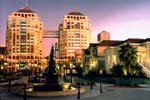 (Roberto Soncin Gerometta/Photo) The Oakland Federal Building is a monumental gateway to the city's revitalized downtown.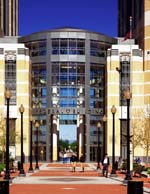 (Michael O'Callahan) The central doorway in the federal building rotunda acts as both an entryway and a thoroughfare - a creative solution to a right-of-way conundrum.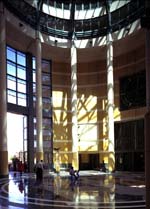 (Michael O'Callahan) Inside the rotunda: the west gateway opens to views of the bay. (KMD) Two Rodeo Drive perspective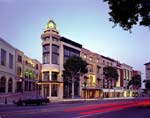 (Paul Bielenburg) The campanile at the corner of Rodeo Drive and Via Rodeo creates an urban icon.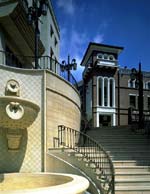 (Paul Bielenburg) Fine detailing, down to street signs and light standards, gives Two Rodeo Drive a European personality.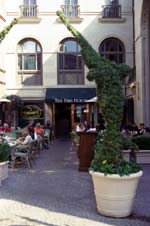 (Paul Bielenburg) Restaurants serve as anchors to the new shopping street.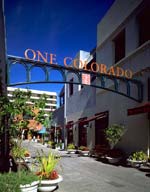 (Richard Barnes) What was once a service alley has become an inviting entrance to Colorado Court.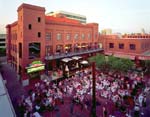 (Richard Barnes) Celebratory spaces draw a new mix of people to downtown Pasadena.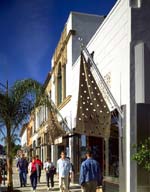 (Richard Barnes) Renovated storefronts along Colorado Boulevard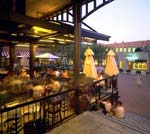 (Richard Barnes) Dining at dusk at Colorado Court |
© 2003 ArchNewsNow.com